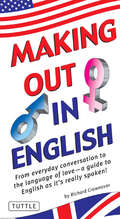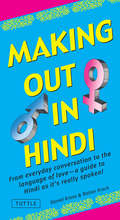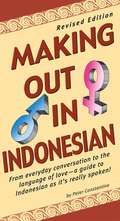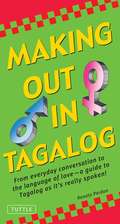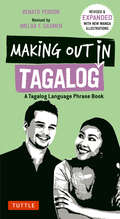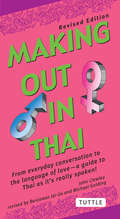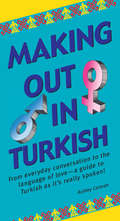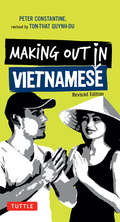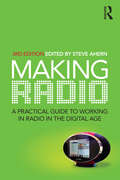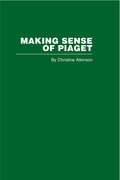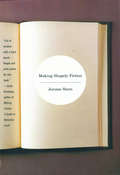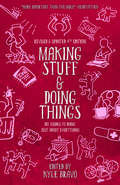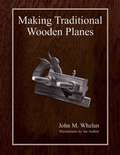- Table View
- List View
Making Out in English
by Richard CrownoverMaking Out in English is a fun, accessible and thorough English phrase book and guide to the English language as it's really spoken.If you are a student, businessman or tourist traveling to the English speaking world and would like to have an authentic and meaningful experience, the key is being able to speak like a local. This friendly and easy-to-use English phrasebook makes this possible. Making Out in English has been revised and redesigned to act as a guide to modern colloquial English for use in everyday informal interactions-giving access to the sort of catchy English expressions that aren't covered in traditional language materials. In the case of difficulties the book can be shown to the person the user is trying to communicate with.This English phrasebook includes:A guide to pronouncing English words correctlyExplanations of basic English grammarComplete translationsUseful and interesting notes on the English language and cultureLots of colorful, fun and useful expressions not covered in other phrasebooks
Making Out in English
by Richard CrownoverMaking Out in English is a fun, accessible and thorough English phrase book and guide to the English language as it's really spoken.If you are a student, businessman or tourist traveling to the English speaking world and would like to have an authentic and meaningful experience, the key is being able to speak like a local. This friendly and easy-to-use English phrasebook makes this possible. Making Out in English has been revised and redesigned to act as a guide to modern colloquial English for use in everyday informal interactions-giving access to the sort of catchy English expressions that aren't covered in traditional language materials. In the case of difficulties the book can be shown to the person the user is trying to communicate with.This English phrasebook includes:A guide to pronouncing English words correctlyExplanations of basic English grammarComplete translationsUseful and interesting notes on the English language and cultureLots of colorful, fun and useful expressions not covered in other phrasebooks
Making Out in English
by Richard CrownoverMaking Out in English is a fun, accessible and thorough English phrase book and guide to the English language as it's really spoken.If you are a student, businessman or tourist traveling to the English speaking world and would like to have an authentic and meaningful experience, the key is being able to speak like a local. This friendly and easy-to-use English phrasebook makes this possible. Making Out in English has been revised and redesigned to act as a guide to modern colloquial English for use in everyday informal interactions-giving access to the sort of catchy English expressions that aren't covered in traditional language materials. In the case of difficulties the book can be shown to the person the user is trying to communicate with.This English phrasebook includes:A guide to pronouncing English words correctlyExplanations of basic English grammarComplete translationsUseful and interesting notes on the English language and cultureLots of colorful, fun and useful expressions not covered in other phrasebooks
Making Out in Hindi: (Hindi Phrasebook
by Rainer Krack Daniel KrasaMaking Out in Hindi is a fun, accessible and thorough Hindi phrase book and guide to the Hindi language as it's really spoken.If you are a student, businessman or tourist traveling to India and would like to have an authentic and meaningful experience, the key is being able to speak like a local. <P><P>This friendly and easy-to-use Hindi phrasebook makes this possible. Making Out in Hindi has been carefully designed to act as a guide to modern colloquial Hindi for use in everyday informal interactions-giving access to the sort of catchy Hindi expressions that aren't covered in traditional language materials. As well as the Romanized form of Hindi, each expression is given in authentic Hindi script (Devanagari), so that in the case of difficulties the book can be shown to the person the user is trying to communicate with.This Hindi phrasebook includes:A guide to pronouncing Hindi words correctly, including vowels, consonants and nasalizationExplanations of basic Hindi grammar, such as, male vs. female, formal vs. informal, loan words and synonymsComplete Hindi translations including DevanagariUseful and interesting notes on the Hindi language and Indian cultureLots of colorful, fun and useful expressions not covered in other phrasebooks
Making Out in Indonesian: Revised Edition (Indonesian Phrasebook)
by Peter Constantine Soe Tjen MarchingMaking Out in Indonesian is a fun, accessible and thorough guide to Indonesian as it's really spoken. It has been updated and expanded to be even more helpful as a guide to modern colloquial Indonesian for use in everyday informal interactions-giving access to the sort of catchy expressions that aren't covered in traditional language materials.<P><P>It includes an introduction to the Indonesian language as well as a pronunciation guide, topical notes throughout on key points of language and culture, and chapters based on typical real-life encounters with speakers of Indonesian, including: o Making acquaintances o Discussing likes and dislikes o Sharing a meal o Going out on the town o Developing a romantic relationship or quarreling, even through to having sex and getting married or splitting up!
Making Out in Spanish: (Spanish Phrasebook)
by Celia EspelletaMaking Out in Spanish is a fun, accessible and thorough Spanish phrase book and guide to the Spanish language as it's really spoken.<P><P>If you are a student, businessman or tourist traveling to Latin America or Spain and would like to have an authentic and meaningful experience, the key is being able to speak like a local. This friendly and easy-to-use Spanish phrasebook makes this possible. Making Out in Spanish has been carefully designed to act as a guide to modern colloquial Spanish for use in everyday informal interactions-giving access to the sort of catchy Spanish expressions that aren't covered in traditional language materials. As well as the Latin script, each expression is now given in phonetics, making pronunciation a breeze. (For example, Buana idea! is also written as BWE-na ee-DE-a!).This Spanish phrasebook includes:Information about Latin American Spanish vs. Spain Spanish as well as regional dialectsA guide to pronouncing Spanish words correctlyExplanations of basic Spanish grammar, such as question forms, male vs. female, formal vs. informal and vowel stressComplete Spanish translations including phonetic scriptUseful and interesting notes on Spanish language and cultureLots of colorful, fun and useful expressions not covered in other phrasebooks
Making Out in Tagalog: (Tagalog Phrasebook)
by Renato PerdonMaking Out in Tagalog is a fun, accessible and thorough Tagalog phase book and guide to the Filipino language as it's really spoken.<P><P>If you are a student, businessman or tourist traveling to the Philippines and would like to have an authentic and meaningful experience, the key is being able to speak like a local. This friendly and easy-to-use Tagalog phrasebook makes this possible. Making Out in Tagalog has been carefully designed to act as a guide to modern colloquial Tagalog for use in everyday informal interactions-giving access to the sort of catchy Filipino expressions that aren't covered in traditional language materials. Each expression is given in Tagalog, so that in the case of difficulties the book can be shown to the person the user is trying to communicate with.This Tagalog phrasebook includes:A guide to pronouncing Tagalog words correctly including vowel combinations and stressing of wordsExplanations of basic Tagalog grammar, such as, word order, pronouns, borrowed words, and polite vs. impolite tensesUseful and interesting notes on Tagalog language and Filipino cultureLots of colorful, fun and useful expressions not covered in other phrasebooks
Making Out in Tagalog: A Tagalog Language Phrase Book
by Renato Perdon Imelda F. GasmenMaking Out in Tagalog is your indispensable guide to contemporary Tagalog language (Filipino) as it's really spoken on the streets of Manila.This best-selling Tagalog phrase book is the perfect introduction to everyday interactions in The Philippines and other Tagalog-speaking countries, and includes colorful slang that'll help rev up your social life. A great way to learn Tagalog, Making Out in Tagalog features a pronunciation guide, and notes on Tagalog language and culture. With Making Out in Tagalog you'll be able to express yourself when: Making new friends Sharing a meal Going out on the town Flirting and getting amorous And much more!Each expression in this book is given in Tagalog and their English translations. It is designed to enhance your experience in using the language (and in a pinch, you can show the Tagalog text to the person you're speaking to). Making Out in Tagalog also includes interesting tips on social norms and cultural practices, eating, social media, hanging out, and other situations. For the savvy traveler, this is a Tagalog phrasebook you won't want to be without!
Making Out in Thai: Revised Edition (Thai Phrasebook)
by Michael Golding Benjawan Jai-Ua John ClewleyMaking Out in Thai is a fun, accessible and thorough Thai phrase book and guide to the Thai language as it's really spoken.Dichan long nai tua khun! Ca phop kan iik muearai?--(I'm crazy about you! When can I see you again?) Answer this correctly in Thai and you may be going on a hot date. <P><P>Incorrectly, and you could be hurting someone's feelings or getting a slap! Thai classes and textbooks tend to spend a lot of time rehearsing for the same fictitious scenarios but chances are while in Thailand you will spend a lot more time trying to make new friends or start new romances--something you may not be prepared for.If you are a student, businessman or tourist traveling to Thailand and would like to have an authentic and meaningful experience, the key is being able to speak like a local. This friendly and easy-to-use Thai phrasebook makes this possible. Making Out in Thai has been revised and redesigned to act as a guide to modern colloquial Thai for use in everyday informal interactions--giving access to the sort of catchy Thai expressions that aren't covered in traditional language materials. As well as the Romanized forms, each expression is given in authentic Thai script (akson thai), so that in the case of difficulties the book can be shown to the person the user is trying to communicate with.This Thai phrasebook includes:A guide to pronouncing Thai words correctlyExplanations of basic Thai grammar, such as, word order and polite vs. impolite formsA guide to male and female usageRomanized forms of words and phrases with tonal markingsComplete translations including Thai script (akson thai)Useful and interesting notes on Thai language and cultureLots of colorful, fun and useful expressions not covered in other phrasebooksTitles in this unique series of bestselling phrase books include: Making Out in Chinese, Making Out in Indonesian, Making Out in Thai, Making Out in Korean, Making Out in Hindi, Making Out in Japanese, Making Out in Vietnamese, Making Out in Burmese, Making Out in Tagalog, Making Out in Hindi, Making Out in Arabic, Making Out in English, More Making Out in Korean, and More Making Out in Japanese.
Making Out in Turkish: Turkish Phrasebook
by Ashley CarmanMaking Out in Turkish is a fun, accessible and thorough Turkish phrase book and guide to the Turkish language as it's really spoken.Sana hayranim! Seni tekrar ne zaman gorecegim?--(I adore you! When can I see you again?) Answer this correctly in Turkish and you may be going on a hot date.<P><P> Incorrectly, and you could be hurting someone's feelings or getting a slap! Turkish classes and textbooks tend to spend a lot of time rehearsing for the same fictitious scenarios but chances are while in Turkey you will spend a lot more time trying to make new friends or start new romances--something you may not be prepared for.If you are a student, businessman or tourist traveling to Turkey and would like to have an authentic and meaningful experience, the key is being able to speak like a local. This friendly and easy-to-use Turkish phrasebook makes this possible. Making Out in Turkish has been carefully designed to act as a guide to modern colloquial Turkish for use in everyday informal interactions--giving access to the sort of catchy Turkish expressions that aren't covered in traditional language materials. Each expression is given in authentic Turkish (turkce) so that in the case of difficulties the book can be shown to the person the user is trying to communicate with. In addition, phonetic spellings are also included making speaking Turkish a breeze. For example "Okay"--Tamam, is also given as ta-MAHM. This Turkish phrasebook includes:A guide to pronouncing Turkish words correctlyExplanations of basic Turkish grammar, such as, double letters, vowel harmony, agglutination, questions, and negationComplete Turkish translations including phonetic spellingsUseful and interesting notes on Turkish language and cultureLots of colorful, fun and useful expressions not covered in other phrasebooksTitles in this unique series of bestselling phrase books include: Making Out in Chinese, Making Out in Indonesian, Making Out in Thai, Making Out in Korean, Making Out in Hindi, Making Out in Japanese, Making Out in Vietnamese, Making Out in Burmese, Making Out in Tagalog, Making Out in Hindi, Making Out in Arabic, Making Out in English, More Making Out in Korean, and More Making Out in Japanese.
Making Out in Vietnamese
by Peter Constantine Ton-That Quynh-DueMaking Out in Vietnamese is a fun, accessible and thorough Vietnamese phrase book and guide to the Vietnamese language as it's really spoken.Anh dien cuong vi em! Chung ta gap lai sau duoc khong? (I m crazy about you! Can we meet again?) Answer this correctly in Vietnamese and you may be going on a hot date. Incorrectly, and you could be hurting someone s feelings or getting a slap! Vietnamese classes and textbooks tend to spend a lot of time rehearsing for the same fictitious scenarios but chances are while in Vietnam you will spend a lot more time trying to make new friends or start new romances something you may not be prepared for.If you are a student, businessman or tourist traveling to Vietnam and would like to have an authentic and meaningful experience, the key is being able to speak like a local. This friendly and easy-to-use Vietnamese phrasebook makes this possible. Making Out in Vietnamese has been carefully designed to act as a guide to modern colloquial Vietnamese for use in everyday informal interactions giving access to the sort of catchy Vietnamese expressions that aren't covered in traditional language materials. Each expression is written in Vietnamese next to the English, so that in the case of difficulties the book can be shown to the person the user is trying to communicate with.This Vietnamese phrasebook includes:A guide to pronouncing Vietnamese words correctlyExplanations of basic Vietnamese grammar, such as, personal pronouns and tonesA guide to male and female usageAuthentic Vietnamese script (Chu Nom) as well as simplified phonetic spellings for all phrasesUseful and interesting notes on Vietnamese language and cultureLots of colorful, fun and useful expressions not covered in other phrasebooksTitles in this unique series of bestselling phrase books include: Making Out in Chinese, Making Out in Indonesian, Making Out in Thai, Making Out in Korean, Making Out in Hindi, Making Out in Japanese, Making Out in Vietnamese, Making Out in Burmese, Making Out in Tagalog, Making Out in Hindi, Making Out in Arabic, Making Out in English, More Making Out in Korean, and More Making Out in Japanese.
Making Out in Vietnamese
by Peter Constantine Ton-That Quynh-DueMaking Out in Vietnamese is a fun, accessible and thorough Vietnamese phrase book and guide to the Vietnamese language as it's really spoken.Anh dien cuong vi em! Chung ta gap lai sau duoc khong?--(I'm crazy about you! Can we meet again?) Answer this correctly in Vietnamese and you may be going on a hot date. Incorrectly, and you could be hurting someone's feelings or getting a slap! Vietnamese classes and textbooks tend to spend a lot of time rehearsing for the same fictitious scenarios but chances are while in Vietnam you will spend a lot more time trying to make new friends or start new romances--something you may not be prepared for.If you are a student, businessman or tourist traveling to Vietnam and would like to have an authentic and meaningful experience, the key is being able to speak like a local. This friendly and easy-to-use Vietnamese phrasebook makes this possible. Making Out in Vietnamese has been carefully designed to act as a guide to modern colloquial Vietnamese for use in everyday informal interactions--giving access to the sort of catchy Vietnamese expressions that aren't covered in traditional language materials. Each expression is written in Vietnamese next to the English, so that in the case of difficulties the book can be shown to the person the user is trying to communicate with.This Vietnamese phrasebook includes:A guide to pronouncing Vietnamese words correctlyExplanations of basic Vietnamese grammar, such as, personal pronouns and tonesA guide to male and female usageAuthentic Vietnamese script (Chu Nom) as well as simplified phonetic spellings for all phrasesUseful and interesting notes on Vietnamese language and cultureLots of colorful, fun and useful expressions not covered in other phrasebooksTitles in this unique series of bestselling phrase books include: Making Out in Chinese, Making Out in Indonesian, Making Out in Thai, Making Out in Korean, Making Out in Hindi, Making Out in Japanese, Making Out in Vietnamese, Making Out in Burmese, Making Out in Tagalog, Making Out in Hindi, Making Out in Arabic, Making Out in English, More Making Out in Korean, and More Making Out in Japanese.
Making Progress in Writing
by Eve BearneChildren's achievements in writing lag behind their achievements in reading, speaking and listening. National tests are beginning to expose this gap and inevitably, it is raising concerns. The issue is not without controversy but regardless of the politics of the situation, national progress in children's writing is both needed and possible.This new book from Eve Bearne makes a valuable contribution towards helping teachers close this gap. Uniquely, it follows the structure of the National Literacy Strategy, whilst examining key areas such as bridging KS2 and KS3 writing, and writing skills beyond the Literacy Hour. Such a structure makes the book incredibly practical and easy to use, providing essential information for both practitioners and academics.
Making Radio: A practical guide to working in radio in the digital age
by Steve Ahern'The distilled wisdom and passion of top practitioners makes this an invaluable guide to making radio in Australia.' - Siobhan McHugh, award-winning radio feature producer and lecturer, University of Wollongong'a very useful hands-on guide to radio production in Australia' - Gail Phillips, Associate Professor of Journalism, Murdoch University'Making Radio has been a core text for all our radio courses since it was written. It covers everything form the basics you need to know when you begin your radio career, to high level skills required for career advancement.' - Kim Becherand, AFTRS Radio DivisionMaking radio programs gets into your blood: it's one of the most stimulating jobs in the world, in a fast-moving industry, at the cutting edge of digital technology.Making Radio is a practical guide for anyone who wants to learn how to make good radio in the era of Radio 2.0. It examines the key roles in radio: announcing, presenting, research, copywriting, producing, marketing and promotions. It also outlines what is involved in creating different types of radio programs: news and current affairs, music, talkback, comedy and WC features, as well as legal and regulatory constraints.With contributions from industry experts, the third edition reflects the impact of digital radio, including multi-platform delivery, listener databases, social media and online marketing. It also examines how radio stations have reinvented their business models to accommodate the rapid changes in communications and listener expectations.
Making Sense of Autistic Spectrum Disorders: Create the Brightest Future for Your Child with the Best Treatment Options
by James Coplan M.D.In this authoritative and empowering book, one of the world&’s leading experts on early child development gives caregivers of children on the autistic spectrum the knowledge they need to navigate the complex maze of symptoms, diagnoses, tests, and treatment options that await them. For more than thirty years, James Coplan, M.D., has been helping families cope with the challenges posed by autistic spectrum disorders (ASD). Each family that walks into his office, he knows, is about to begin a journey. With this book, he lays out the steps of that journey. Dr. Coplan brings you into the treatment rooms and along for the tests and evaluations, and provides the kind of practical hands-on guidance that will help you help your child with ASD through every phase of life. At a time when ASD has become the subject of wild theories and uninformed speculation, Dr. Coplan grounds his recommendations in reality. He helps you understand for yourself where your child may be on the spectrum that includes autism, Asperger Syndrome, and Pervasive Developmental Disorder-Not Otherwise Specified. His clear, comprehensive, and compassionate advice prepares you to make informed medical decisions, evaluate the various educational and therapeutic alternatives, and find answers to such fundamental questions as • How do I optimize my child&’s long-term potential?• Which interventions will best serve my child?• How do the various therapies work, and what is the evidence to support them?• What is the best way to teach my child? This book empowers you to be an expert advocate for your child, so that you&’ll know when to say no to an ill-advised therapy or medication and can make with confidence the hundreds of important decisions you will face in the years ahead. For every parent who has made the painful transition from &“Why did this happen?&” to &“What can we do to help our child?,&” here is the indispensable guidebook you&’ve been waiting for.
Making Sense of Human Anatomy and Physiology: A Learner-Friendly Approach
by Earle Abrahamson Jane LangstonDesigned to be user-friendly and informative for both students and teachers, this book provides a road map for understanding problems and issues that arise in the study of anatomy and physiology. Students will find tips to develop specific study skills that lead to maximum understanding and retention. They will learn strategies not only for passing an examination or assessment, but also for permanently retaining the fundamental building blocks of anatomical study and application. For the teacher and educator, the book provides useful insight into practical and effective assessment techniques, explores the subject matter from a learning approach perspective, and considers different methods of teaching to best to convey the message and meaning of anatomy and physiology. Supported by clear diagrams and illustrations, this is a key text for teachers who want a useful toolbox of creative techniques and ideas that will enhance the learning experience. In addition to the wealth of information it provides, Making Sense of Human Anatomy and Physiology sets in place a bedrock of learning skills for future study, regardless of the subject. Students of beauty therapies, holistic and complementary therapies, and fitness professionals--yoga teachers, personal trainers, sports coaches, and dance teachers--will gain not only a basic understanding of anatomy and physiology, but also the skills to learn such a subject. Allied professionals in nursing, biomedical science, dentistry, occupational therapy, physiotherapy, midwifery, zoology, biology and veterinary science will also find this book an invaluable resource. The final chapters offer suggestions for the further exploration of concepts, assessment, learning activities, and applications.
Making Sense of Piaget: The Philosophical Roots
by C. AtkinsonThis book was first published in 1983.
Making Shapely Fiction
by Jerome SternA deft analysis and appreciation of fiction--what makes it work and what can make it fail. Here is a book about the craft of writing fiction that is thoroughly useful from the first to the last page--whether the reader is a beginner, a seasoned writer, or a teacher of writing. You will see how a work takes form and shape once you grasp the principles of momentum, tension, and immediacy. "Tension," Stern says, "is the mother of fiction. When tension and immediacy combine, the story begins." Dialogue and action, beginnings and endings, the true meaning of "write what you know," and a memorable listing of don'ts for fiction writers are all covered. A special section features an Alphabet for Writers: entries range from Accuracy to Zigzag, with enlightening comments about such matters as Cliffhangers, Point of View, Irony, and Transitions.
Making Short Films
by Jim PiperAccompanying DVD of thirty short films offers an instructive mini film festival Shows beginners how to make meaningful films without fancy equipment Great for film students and independent filmmakers Want to make an art film, a documentary, a video biography? Here’s how to create real movies using consumer digital video format-without spending a lot of money or time. Author Jim Piper has taught filmmaking for more than thirty years-and along with his technical expertise, he brings entertaining anecdotes and great examples. His descriptions of more than one hundred student films, illustrated with three hundred stills, offer inspiration for beginners, and the accompanying DVD showcases thirty examples that comprise an intriguing and instructive mini film festival.Allworth Press, an imprint of Skyhorse Publishing, publishes a broad range of books on the visual and performing arts, with emphasis on the business of art. Our titles cover subjects such as graphic design, theater, branding, fine art, photography, interior design, writing, acting, film, how to start careers, business and legal forms, business practices, and more. While we don't aspire to publish a New York Times bestseller or a national bestseller, we are deeply committed to quality books that help creative professionals succeed and thrive. We often publish in areas overlooked by other publishers and welcome the author whose expertise can help our audience of readers.
Making Soap: DIY Bath & Body Products Made with All-Natural Scents, Oils, and Colors
by Agnes StuberWelcome to the world of homemade soap! It is perfectly possible to make soap at home—from simple everyday soaps to fragrant masterpieces. Making Soap describes what cold-stirred craft soap is, why it works, what you need, and how to make it. Read about fatty acids, essential oils, natural dyes, and other materials that give soap its characteristics. Recipes include: Scrubbing poppy soap Facial soap with activated charcoal Skin-softening bath bomb Rosy clay soap And so much more! Learn how to make your own soap from ingredients you already have at home with Making Soap.
Making Stuff and Doing Things: DIY Guides to Just About Everything
by Kyle BravoWhen you're young, broke, and in search of a life of adventure, Making Stuff and Doing Things is the most useful book on the planet. It's been called "more important than the Bible." It's an indispensable handbook full of basic life skills for the young punk or activist, or for anyone who's trying to get by, get stuff done, and live life to the fullest without a lot of money. The book started in the 90s as a series of zines, with dozens of contributors setting down the most important skills they knew in concise, often hand-written pages. If you want to do it yourself or do it together, this book has it all, from making your own tooth paste to making your own art and media, feeding, clothing, cleaning, and entertaining yourself, surviving on little, living on less, and staying healthy on all your life's adventures. You'll never be bored again.
Making Traditional Wooden Planes
by John M. WhelanJohn Whelan unlocks the fascinating secrets of an almost lost art: wooden planemaking. For those curious about the ingenious ways of the craft, this book lays out clear, step-by-step instructions that will enable any woodworker to make a plane. Each chapter (covering 20 different types of planes and spokeshaves) is fully illustrated by the author's line drawings. In addition, there are chapters on the history and alternative methods of planemaking, making plane irons, and the tuning and using of wooden planes. Every chapter that details the construction of a particular plane starts with a photograph of the plane that has been made by the author. As you would expect from Mr. Whelan, this book is the finest and most complete work on the making of wooden planes in print. The reader will enjoy it even if he never puts blade to wood. Should he make a plane or two, he will find Making Traditional Wooden Planes most satisfying
Making Vegan Frozen Treats: 50 Recipes for Nondairy Ice Creams, Sorbets, Granitas, and Other Delicious Desserts. A Storey BASICS® Title (Storey Basics)
by Nicole WestonEnjoy all of your favorite ice creams — without the dairy! In this Storey BASICS® guide, Nicole Weston shows you how to make vegan “ice creams” right at home, with soy, almond, or coconut milk. Fill your bowl with classics like vanilla, chocolate, and strawberry, or get creative with flavors like chai tea, peanut butter and banana, and coconut-raspberry-lime. Weston also includes recipes for vegan sorbets, granitas, pops, and even vegan cookies for making dairy-free ice cream sandwiches.
Making Your Creative Mark
by Eric MaiselEric Maisel's prolific, multifaceted career is a testament to his profound understanding of what it takes to live out one's creative ambitions. A therapist who is also a bestselling author, coach (and coach trainer), columnist for Professional Artist magazine, and featured blogger for Psychology Today and the Huffington Post, Maisel is an expert on all that blocks the creative. In Making Your Creative Mark, Maisel distills his decades of coaching, teaching, listening, and creating into nine keys, including Passion, Confidence, Empathy, Stress, and Relationship. Each key's lesson helps creators implement real solutions to their individual challenges. Whether they are writers, painters, actors, composers, or craftspeople, readers will learn to "unlock" what has kept them from beginning, continuing, completing -- and succeeding.
Making Your Move to One of America's Best Small Towns: How to Find a Great Little Place as Your Next Home Base
by Norman CramptonFor those looking to raise a family in a storybook American town, or a change of pace from hectic city life, this book is the answer.
